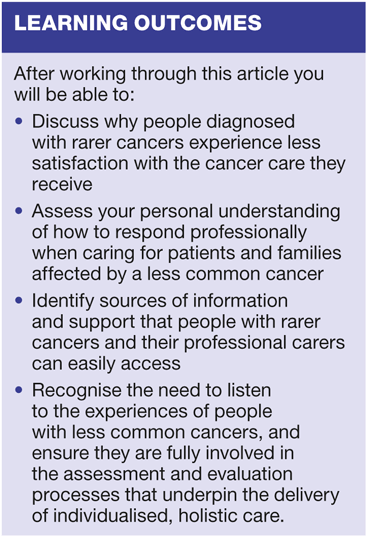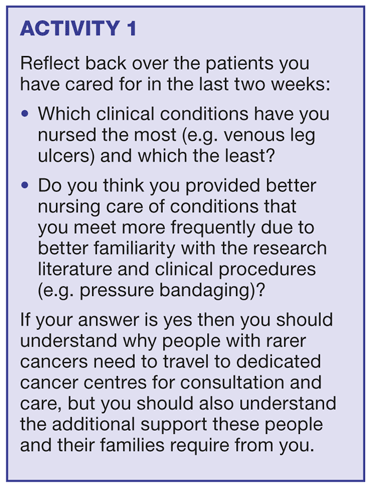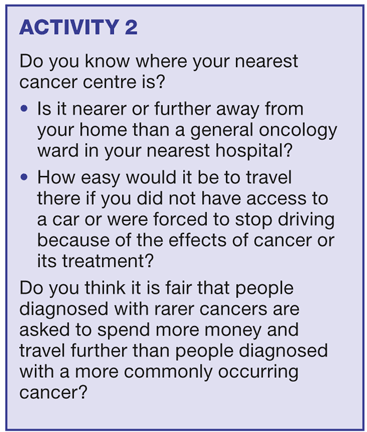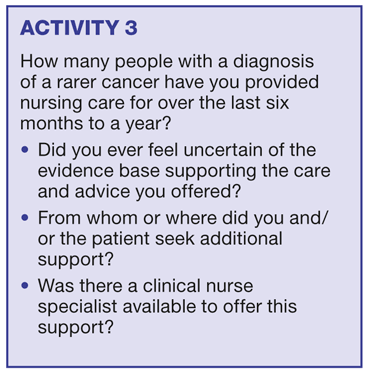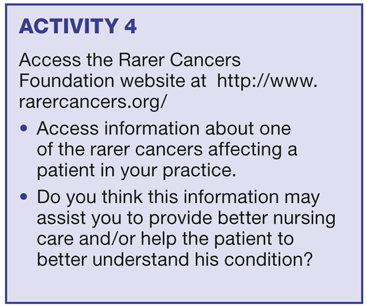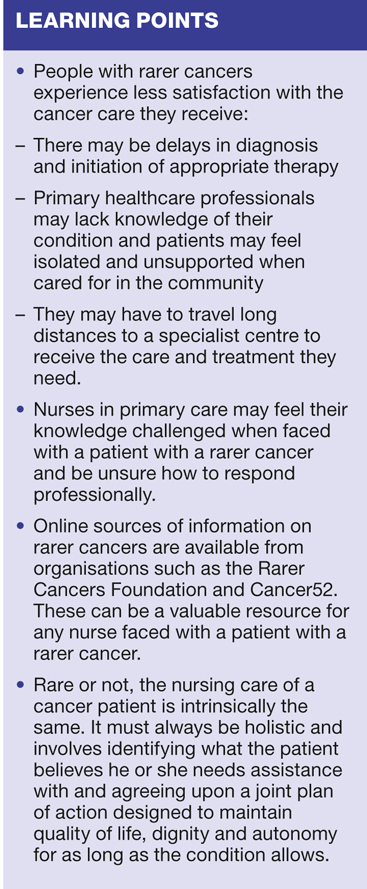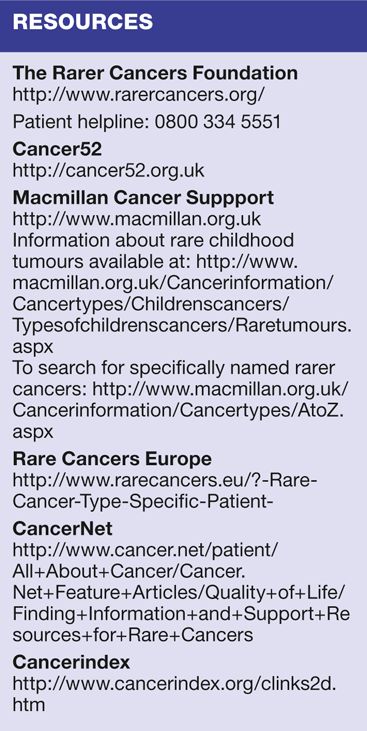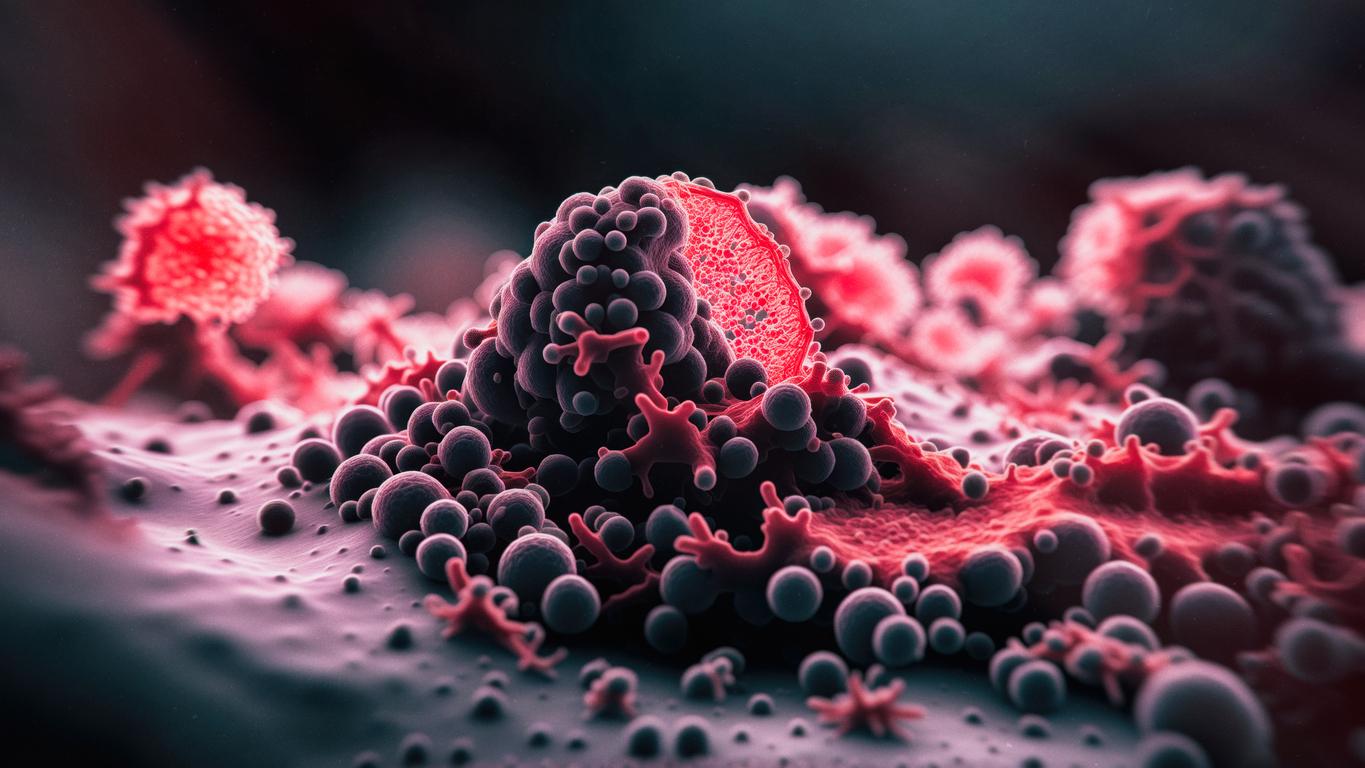
Understanding the needs of patients with rarer cancers
Anthony Duffy
Anthony Duffy
MSc, BSc (Hons), RN, RNT, ITEC, MBPsS
Nurse tutor, College of Human and Health Sciences, Swansea University
Rarer cancers, defined as affecting fewer than 6 per 100,000 people a year, are responsible for over half of all cancer-related deaths. Their individual rarity makes it difficult for primary healthcare professionals to achieve expertise, resulting in patients feeling isolated, unsupported and even abandoned when cared for in the community. More effort is now being made to better understand the specific feelings and needs of these people.
Cellular reproduction is the process by which the body keeps itself healthy; replacing old, worn or damaged cells with newer ones.1 It is widely understood that the vast majority of cancers in humans start with just one cell in the body producing a daughter cell which is genetically damaged. This cell manages to evade detection by the immune system and then creates daughter cells of its own, with the abnormality often becoming more pronounced with each reproduction. This small collection of abnormal cells can continue to grow into a tumour that becomes large enough to threaten the normal function of local cells and organs.2
How a cell becomes damaged in the first place can vary, although environmental and behavioural factors are often highlighted as main causative factors.3 For example, cigarette smoking has been recognised as the main cause of a variety of cardiovascular diseases and cancers although the disease it is most commonly associated with is lung cancer.4 In an attempt to rationalise and justify their choice to continue smoking, however, some smokers may not share the general population's belief in the dangers of their habit.5
Metastasis occurs when cancerous cells develop the ability to leave their site of origin and travel, often via the lymphatic system, to other parts of the body where they can take 'root' and grow uncontrollably.6 Metastatic cells that originate in one part of the body commonly embed themselves in predictable sites. For example, bone is the most common metastatic site for prostate cancer.7 Such knowledge can aid accuracy in diagnosis and estimates of progression.8
COMMON CANCERS
Excellent data, gathered by bodies such as the World Health Organization9 and British organisations such as the National Cancer Intelligence Network10 and Cancer Research UK,11 make it reasonably easy to identify which are the commonly diagnosed cancers, both worldwide and in the UK. Such data has been used by British governments of the past 20 years to promote public health policies and health promotion programmes that emphasise how the alteration of common 'pathogenic' behaviours, such as tobacco smoking, can reduce the risk of developing many common cancers.
White papers, such as the NHS Cancer Plan,12 have highlighted to health professionals that the most commonly occurring cancers in the UK at the end of the last century were breast, colorectal, prostate and lung cancer.12 These four cancers combined continue to account for over half of all cancers diagnosed in the UK.13 In addition to these, pancreatic, oesophageal, stomach, bladder and ovarian cancers have also been regularly identified as major killers.14 Indeed, the UK currently has the highest incidence in Europe of oesophageal cancer, which is linked to behavioural factors such as heavy drinking, obesity, smoking and a diet low in fruit and vegetables.15
RARER CANCERS
A rarer cancer may be considered to be one not normally found in the top twenty of common cancer lists provided by organisations such as those named above. Within Europe, rarer cancers are defined as diseases with a prevalence of fewer than six cases in every 100,000 people per year.16 In the UK, however, over half of all cancer-related deaths are due to the combined total of rarer cancers,17 so the term 'rarer' may be a misnomer.
Some of the rarer cancers are located in unusual anatomical sites, such as ductal carcinoma in salivary glands,18 but some may be situated in common sites. For example, breast cancer is the most common form of cancer diagnosed in women in the UK, but basal type breast cancer and cytosarcoma phyllodes are just two of several unusual 'special types' of breast cancer requiring a different treatment approach to the more common breast cancers.19 An unusual cancer in a common cancer site can result in late or incorrect diagnosis, giving rise to incorrect initial medical response.16,20
RESPONDING APPROPRIATELY
The National Institute for Health and Clinical Excellence (NICE) currently provides a large and growing number of guidance documents designed to aid the organisation of cancer services and advise upon a number of interventional procedures.21 However, NICE requires sufficient research evidence upon which to base its recommendations. This means that it tends to focus far more upon the common cancers, for which we have a lot of research data, than it does upon the rarer cancers, where rarity limits access to sufficient numbers of subjects to conduct meaningful research and the evidence base is limited. Late or incorrect diagnosis of rarer cancers may be followed by problems accessing appropriate treatments and clinical expertise because of the paucity of the evidence base. In addition, there may be a lack of interest in the development of new, more effective therapies because of limitations in the commercial market.16
For many years it has been recognised that when health care professionals have frequent and repetitive contact with specific diseases and conditions, clinical expertise and patient outcomes are improved. It was in response to this understanding that a 'hub and spokes' model of cancer care services was adopted in the UK; people diagnosed with rarer cancers are treated together in a few dedicated cancer centres by professionals more familiar with their needs.12 Despite this, there are still many people with rarer cancers who experience delays in diagnosis and the initiation of appropriate interventions.22,23
The hub and spokes model of cancer care means that people diagnosed with rarer cancers frequently need to travel much further than those with more common cancers in order to access the expertise and specialist care they need.20 It is important that we recognise the additional effort, time and financial burden that this can impose on these individuals and their families.
THE NEEDS OF PEOPLE WITH RARER CANCERS
The psychological impact a cancer diagnosis can have upon a person and their family has been recognised for many years. Over the past ten years this knowledge has informed several key national documents designed to identify appropriate health care responses to patient needs.12,24 Practice and service provision recommendations have been based upon research focused on the common cancer groups and there is a sense of uncertainty about whether these general recommendations always recognise or meet the specific needs of people with rarer cancers. However, the rising profile of people diagnosed with rarer cancers is evident in England, where the first ever national listening event for patients and their families affected by rarer cancers has recently been held.20 This follows the important National Cancer Patient Experience Survey23 which, for the first time, attempted to include patients with all types of cancers. It appears that the specific needs of those with less common cancers are finally being explored rationally and recorded systematically.
Psychologically, an important feature of a rarer cancer diagnosis is the possibility that the patient may feel isolated, unsupported and possibly even abandoned when cared for in the community.25 Their GP, understandably, may know very little about their condition, resulting in uncertainty about how to assess their need or identify appropriate means of support. Research, based on interviews with survivors of rarer cancers who had been discharged back into the care of their GP, suggests that hospital based clinical nurse specialists, in partnership with suitably trained district nurses, may significantly improve the perceived levels of support and understanding many such patients feel they receive.25 Such an approach appears to be supported by many people with rarer cancers.20
The benefits of developing supportive social networks have been identified many times. The development of such networks, however, can be difficult when there are fewer people to link up with. Health professionals have been encouraged to direct patients towards participating in email discussion groups26 in order to obtain the benefits of social networking with people who share a similar diagnosis and similar difficulties in obtaining good information regarding their diagnosis, treatment and prognosis.
All health professionals, including nurses, should be continually searching for ways in which to expand their knowledge and ability to effectively care for their patients. Those with specialist knowledge can join email groups established by people diagnosed with a rare cancer, such as medullary thyroid carcinoma, and which have become an accessible and useful online source of information and support.27 However, it is professionally easier to meet information needs using this medium, than to respond to emotional needs.27 Healthcare professionals contributing to e-mail forums could potentially open themselves to the criticism of being too focused upon the facts and less upon the person.
The establishment of online support networks has become much easier recently due to the development of sites such as Twitter and Facebook. It has also become much easier to develop web sites designed to cater for the needs of minority groups.
Several web sites in Britain have improved nurse and patient access to data and support regarding diagnosis, and living with, an uncommon cancer.
SOURCES OF INFORMATION
The web addresses of many organisations providing information that may be useful to any healthcare professional caring for a person or family affected by a rarer cancer, with all the associated problems this entails, are included in the resources section.
A Google search will reveal many sites that can provide information or support concerning rarer cancers. Some of these appear to be run by just one person, others are run by groups of people who appear to have been affected by a diagnosis of uncommon cancer sometime in the past. Some of these sites try to identify supportive sites and provide a list of hyperlinks, e.g. http://www.bestcancersites.com/rare/. There is, however, a need to issue a warning about sources of information on the Internet. Please be wary of any site that contains advertising or tries to sell you something. It is probably best to navigate away from these pages and focus upon those sites discussed here and listed in the resources section.
Rarer Cancers Foundation
The Rarer Cancers Foundation (previously Rarer Cancers Forum), a national charity based in the UK, is probably Britain's leading voice for people diagnosed with rarer cancers. Since 2007 it has provided a web site that attempts to expand support, from the emailed sharing of experiences to the provision of educational resources for patients, their families, and the health professionals caring for them. It also provides a dedicated helpline for those seeking detailed advice.
Any nurse, or other health professional who feels their knowledge challenged after coming into contact with a patient diagnosed with a less common cancer would be well advised to visit the RCF web site for information and support. You can also learn a lot about the issues faced by these patients by clicking the 'Policy' tab near the top of the home page on the RCF website.
The RCF has also found sufficient voice to start political lobbying. In 2010 it published a report that was very critical of the arbitrary criteria which NICE applies when recommending that certain life-extending drugs, available elsewhere in the world, should not be made available to people with less common cancers in the UK. The same report, whose criticism was supported by Cancer ResearchUK, also criticised the slow pace at which NICE assesses drug efficacy against cost effectiveness.28
Cancer52
Cancer52 is another British site and an excellent source of information. Their motto is:
'The common voice for less common cancers.'
It is an 'umbrella' organisation that represents 41 members with interests in rarer cancers. You may find the 'Useful Info' tab near the top of the page professionally useful and interesting.
Macmillan Cancer Support
This is an excellent and well known British cancer charity. In addition to its extensive work in providing information and support and political lobbying, it provides information about rare childhood tumours and specifically named rarer cancers.
Rare Cancers Europe
This organisation, based in Germany, provides a superb list of sites and support networks that may be very useful for nurses to know about ahead of their rarer cancer patient's assessment of needs.
CancerNet
This site is supported by the American Society of Clinical Oncology. It provides a useful list of sites dedicated to better understanding the needs of people diagnosed with rarer cancers. Some of the sites described above are also listed here.
Cancerindex
This site, although not very easy to navigate, can provide useful information regarding rarer cancers for both nurses and their patients.
NURSING CARE
It is important to emphasise that when a person receives a diagnosis of cancer, whether it is a very common cancer or one that is only seen in one person every seventeen thousand, the nursing care of that person remains intrinsically the same. Nursing care should always be patient focused and holistic in nature. It involves identifying what the patient believes he or she needs assistance with and agreeing upon a joint plan of action designed to maintain quality of life, dignity and autonomy for as long as the condition allows.29 Patient assessment is an activity that starts and finishes with the patient.
Unless there are successful medical interventions available (or the patient is of an age that death through natural causes is more likely to occur than death due to the cancer, as is believed to be the case with prostate cancer30,31), cancer is a progressive, terminal illness. Today, however, cancer is a far more treatable condition. Many more patients survive, or are treated for long periods. In many ways the survivors need more specialist input and support than those with terminal illness.
CONCLUSION
There is much knowledge of rarer cancers that primary healthcare professionals, especially when working as generalists in the community, will not possess. As a nurse you will also be aware that the possession of lifelong learning skills that allow you to effectively review the evidence base regarding a rarer cancer, should such a patient becomes a member of your caseload, is a requirement of your professional registration.32
You will also need to be aware of your strengths and weaknesses and be comfortable enough to admit lack of specialist knowledge of a disease with which you will, by its very nature, have infrequent contact. When faced with such a situation you should also be comfortable about using your professional network, database searching and critical analysis skills, in partnership with the patient, in order to identify and appraise the relevance and usefulness of any research or information that the patient may have discovered. Such an approach may see the start of a rewarding and therapeutic nurse/patient relationship.
REFERENCES
1. Vickers PS. (2009a) Cell and body tissue physiology. In Nair M, Peate I. (eds) Fundamentals of Applied Pathophysiology. Wiley-Blackwell. Chichester. 2009. pp1-33
2. Vickers PS. Cancer. In Nair M, Peate I. (eds) Fundamentals of Applied Pathophysiology. Wiley-Blackwell. Chichester. 2009. pp 34-60
3. Ford BM., Kaphingst KA. Lay interpersonal sources for health information related to beliefs about the modifiability of cancer risk. Cancer Causes and Control 2009; 20(10): 1975-1983
4. Cancer Research UK, 2010. Lung cancer risks and causes. http://cancerhelp.cancerresearchuk.org/type/lung-cancer/about/lung-cancer-risks-and-causes
5. Heikkinen H, Patja K, Jallinoja P. Smokers accounts on the health risks of smoking: why is smoking not dangerous for me? Social Science and Medicine 2010; 71(5): 877-883
6. Hanahan D, Weinberg RA. The hallmarks of cancer. Cell 2000; 100(1): 57-70
7. deSibio G, French SW. Metastatic Patterns of Cancers: results from a large autopsy study. Archives of Pathology & Laboratory Medicine 2008; 132(6): 931-939
8. Chen LL, Blumm N, Christakis NA, Barabasi A-L, Deisboeck DS. Cancer metastasis networks and the prediction of progression patterns. British Journal of Cancer 2009; 101:749-758
9. World Health Organization, 2008. World Health Statistics. http://www.who.int/whosis/whostat/EN_WHS08_Full.pdf
10. National Cancer Intelligence Network, 2011. Home page. http://www.ncin.org.uk/home.aspx
11. Cancer Research UK, 2011. Cancer statistics for the UK. http://info.cancerresearchuk.org/cancerstats/
12. Department of Health, 2000. The NHS Cancer Plan; a plan for investment, a plan for reform. DH. London http://www.dh.gov.uk/prod_consum_dh/groups/dh_digitalassets/@dh/@en/documents/digitalasset/dh_4014513.pdf
13. Cancer Research UK, 2011. Cancer incidence for common cancers - UK statistics. http://info.cancerresearchuk.org/cancerstats/incidence/commoncancers/#Twenty
14. Cancer Research UK, 2011. Deaths from common cancers - UK mortality statistics. http://info.cancerresearchuk.org/cancerstats/mortality/cancerdeaths/
15. World Cancer Research Fund, 2011. World Cancer Statistics: oesophageal cancer. http://www.wcrf-uk.org/research/cancer_statistics/oesophageal_cancer_rates.php
16. Rare Cancers Europe, 2011. http://www.rarecancers.eu/?-Rare-Cancer-Type-Specific-Patient-
17. Cancer52, 2011. http://www.cancer52.org.uk/
18. RARECARE, 2011. Surveillance of rare cancers in Europe: list of rare cancers. http://www.rarecare.eu/rarecancers/Rare_Cancers_list_March2011.xls
19. Cancer Research UK, 2011. Rare types of breast cancer. http://cancerhelp.cancerresearchuk.org/type/breast-cancer/about/types/rare-types-of-breast-cancer
20. National Cancer Action Team, 2010. National Rare Cancer Conference Report. http://www.mccn.nhs.uk/userfiles/documents/National%20rarer%20cancer%20conference%20FINAL(1).pdf
21. National Institute for Health and Clinical Excellence, 2011) NICE guidance by topic: cancer. http://www.nice.org.uk/guidance/index.jsp?action=byTopic&o=7165&view=all
22. Rarer Cancers Foundation, 2011. http://www.rarercancers.org/
23. Department of Health, 2010. National Cancer Patient Experience Survey. http://www.dh.gov.uk/en/Publicationsandstatistics/Publications/PublicationsStatistics/DH_122516
24. National Institute for Clinical Excellence, 2004. Improving Supportive and Palliative Care for Adults with Cancer: the manual. NICE. London
25. Griffiths J, Willard C, Burgess A, Amir Z, Luker K. Meeting the ongoing needs of survivors of rarer cancer. European Journal of Oncology Nursing 2007; 11:.434-441
26. Calhoun RD. Practice Guidelines for Patients with Rare Cancers. Cancer Practice 1998; 6(4):.247-250
27. Schultz PN. Providing information to patients with a rare cancer: using internet discussion forums to address the needs of patients with medullary thyroid carcinoma. Clinical Journal of Oncology Nursing 2002; 6(4): 219-222
28. Cancer Research UK, 2011. Cancer news: people with rarer cancers 'still denied access to cancer treatments.' http://info.cancerresearchuk.org/news/archive/cancernews/2010-03-17-People-with-rarer-cancers-still-denied-access-to-treatments
29. Pearce CM, Duffy A. Holistic Care. In Lugton J, McIntyre R. (eds) Palliative Care: the nursing role (2nd Ed). Elsevier Churchill Livingstone. London. 2005
30. Shroder SH, Hugosson J, Roobol MJ, et al. Screening and prostate-cancer mortality in a randomized European study. The New England Journal of Medicine 2009; 360(13):1320-1328
31. Andriole GL, Crawford ED, Grubb 3rd RL, et al. Mortality Results from a Randomized Prostate-Cancer Screening Trial. New England Journal of Medicine 2009; 360(13):.1310-1319
32. Nursing and Midwifery Council. The Code: standards of conduct, performance and ethics for nurses and midwives. NMC. London. 2008
Related articles
View all Articles

